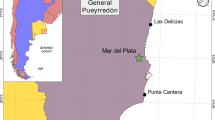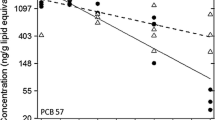Abstract
Tissue samples from five harbor seals (Phoca vitulina) have been analyzed for coplanar and other polychlorinated biphenyl (CB) congeners, in order to measure variations in levels and patterns of the CBs. Blubber samples contained the highest levels of CBs in all animals; kidney and liver were relatively high-level tissues. CB-153 and CB-138 were the most abundant CB congeners in all samples analyzed.
Variations in the patterns of CB congeners in tissues were studied by principal component analyses and multivariate analysis of variance. The CB congener patterns in seals from different geographical regions had distinctly different patterns, whereas the patterns appeared quite similar in tissues within each seal. Based on multivariate analysis of variance, it was, however, possible to detect some systematic variation of the principal components with individual seals and with tissue type within the seals.
The assessment of differences in CB congener patterns was possible by comparison to results obtained by repeated analyses of a quality control sample. The calculated dioxin toxic equivalents of the CB congeners followed the levels of the CB congeners, with the highest levels being found in the blubber samples.
Similar content being viewed by others
References
Addison RF (1975) Organochlorine compounds in aquatic organisms: Their distribution, transport, and physiological significance. In: Lockwood APM (ed) Effects of pollutants on aquatic organisms. Cambridge University Press, p 127
Aguilar A (1985) Compartmentation and reliability of sampling procedures in organochlorine pollution surveys of cetaceans. Residue Reviews 95:91–114
— (1987) Using organochlorine pollutants to discriminate marine mammal populations: A review and critique of the methods. Mar Mamm Sci 3(3):242–262
Ahlborg UG, Hanberg A, Kenne K (1992) Risk assessment of polychlorinated biphenyls (PCBs). Nordic Council of Ministers. Nord:26
Ballschmieter K, Rappe C, Buser H R (1989) Chemical properties, analytical methods and environmental levels of PCBs, PCTs, PCNs and PBBs. In: Kimbrough RD and Jensen AA (eds) Halogenated biphenyls, terphenyls, naphtalenes, dibenzodioxins and related products. Elsevier, Amsterdam
de Boer J, Reuterg»rdh L, van der Meer J, Calder J A (1992) Report on the ICES/IOC/OSPARCOM intercomparison exercise on the analysis of chlorobiphenyl congeners in marine media—second step. Int Council for the Exploration of the Sea, Copenhagen, Denmark
de Voogt P, Wells DE, Reuterg»rdh L, Brinkman UATh (1990) Biological activity, determination and occurrence of planar, monoand di-ortho PCBs. Int J Environ Anal Chem 40:1–46
Dietz R, Heide-Jørgensen M-P, Härkönen T, Teilmann J, Valentin N (1991) Age determination of European harbour seal, Phoca Vitulina L. Sarsia 76:17–21
Duinker JC, Knap AH, Brinkley KC, Van Dam GH, Darrel-Rew A, Hillebrand MTJ (1988) Method to represent the qualitative and quantitative characteristics of PCB mixtures. Marine mammal tissues and Commercial mixtures as examples. Mar Pollut Bull 19(2):74–79
Duinker JC, Hillebrand MTJ, Zeinstra T, Boon JP (1989) Individual chlorinated biphenyls and pesticides in tissues of some cetacean species from the North Sea and the Atlantic Ocean; Tissue distribution and biotransformation. Aquat Mamm 15(3):95–124
Erickson MD (1986) The analytical chemistry of PCBs. Butterworth, Boston
Frank R, Ronald K, Braun HE (1973) Organochlorine residues in Harp seals (Pagohilius groenlandicus) caught in eastern Canadian waters. J Fish Res Board Can 30(8):1053–1063
Gonzalez MJ, Fernandez MA, Hernandez LM (1991) Levels of chlorinated insecticides, total PCBs and PCB congeners in Spanish Gull eggs. Arch Environ Contam Toxicol 20:343–348
Griepink B, Wells DE, Ferreira MF (1988) The certification of the contents (mass fractions) of chlorobiphenyls (IUPAC Nos 28, 52, 101, 118, 138, 153 and 180) in two fish oils. Commission of the European Communities, Community Bureau of Reference. EUR 11520 EN
Hall AJ, Law RJ, Wells DE, Harwood J, Ross HM, Kennedy S, Allchin CR, Campbell LA, Pomeroy PP (1992) Organochlorine levels in common seal (Phoca vitulina) which were victims and survivors of the 1988 phocine distemper epizootic. Sci. Total Environ 115:145–162
Hansen LG (1987a) Environmental toxicology of polychlorinated biphenyls. In: Safe S (ed) Environmental Toxin Series 1. Springer-Verlag, NY
— (1987b) Food chain modification of the composition and toxicity of polychlorinated biphenyl (PCB) residues. Rev Environ Contam Toxicol 3:149–212
Haraguchi K, Bergman A, Athanasiadov M, Haglund P, Olsson M, Masuda Y (1990) PCB methyl sulphones in seals from Swedish environments. In: Hutzinger O, Fiedler H (ed) Organohalogen compounds (conference proceedings from Dioxin '90.) Vol 1, pp 415–418
Härkönen T, Heide-Jørgensen M-P (1990) Comparative life histories of east Atlantic and other harbour seal populations. Ophelia 32(3):211–234
Have P, Nielsen J, Bøtner A (1991) The seal death in Danish waters 1988 2. Virological Studies. Acta Vet Scand 32:211–219
Heide-Jørgensen M-P (1992) Retrospective of the 1988 European seal epizootic. Dis Aquat Org 13:37–62
Heje NI, Henriksen P, Aalbæk B (1991) The seal death in Danish waters 1988. 1. Pathological and bacteriological studies. Acta Vet Scand 32:205–210
Holden AV (1978) Pollutants and seals—A review. Mammal Rev 8(1–2):53–66
Kawai S, Fukushima M, Miyazaki N, Tatsukawa R (1988) Relationship between lipid composition and OC kevels in the tissues of a striped dolphin. Mar Pollut Bull 19(3):129–133
Law RJ, Allchin CR, Harwood J (1989) Concentration of organochlorine compounds in the blubber of seals from Eastern and Northeastern England, 1988. Mar Pollut Bull 20(3):110–115
Luotamo M (1991) Congener specific assessment of human exposure to polychlorinated biphenyls. Chemosphere 23(11–12):1685–1698
Lutz RJ, Dedrick RL (1987) Physiologic pharmacokinetic modelling of polychlorinated biphenyls. In: Safe S (ed) Environmental Toxin Series 1. Springer-Verlag, NY
Macdonald CR, Norstrom RJ, Turle R (1992) Application of pattern recognition techniques to assessment of biomagnification and sources of polychlorinated multicomponent pollutants, such as PCBs, PCDDs and PCDFs. Chemosphere 25(1–2):129–134
Massé R, Martineau D, Tremblay L, Béland P (1986) Concentrations and chromatographic profile of DDT metabolites and PCB residues in stranded Beluga Whales (Delphinapterus leucas) from the St. Lawrence Estuary, Canada. Arch Environ Contam Toxicol 15:567–579
Mitchell SH, Kennedy S (1992) Tissue concentrations of organochlorine compounds in common seals from the coast of Northern Ireland. Sci Total Environ 115:163–177
Morrison DF (1976) Multivariate statistical methods (2 ed). McGraw-Hill, NY
Nørgaard N, Heje Larsen B (1991) Age determination of harbour seals Phoca vitulina by cementum growth layers, X-ray of teeth, and body length. Dan Rev Game Biol 14(4):17–32
Olsson M, Bergman A, Jensen S, Kihlström J E (1990) Effects of various fractions of PCB on mink reproduction. Preliminary results from experimental studies within the Swedish seal project. In: Hutzinger O, Fiedler H (ed) Organohalogen compounds (conference proceedings from Dioxin '90). Vol 1, pp 393–396
Parkinson A, Safe S (1987) Mammalian biologic and toxic effects of PCBs. In: Safe S (ed) Environmental Toxin Series 1. Springer-Verlag, NY
Reijnders PJH (1980) Organochlorine and heavy metal residues in harbour seals from the Wadden Sea and their possible effects on reproduction. Neth J Sea Res 14(1):30–65
— (1986) Reproductive failure in harbour seals feeding on fish from polluted coastal waters. Nature 324:456–457
Ronald K, Frank RJ, Dougan JL, Frank R and Braun HE (1984) Pollutants in harp seals (phoca groenlandica). I. Organochlorines. Sci Tot Environ 38:133–152
Safe S, Safe L, Mullin M (1987) Polychlorinated biphenyls: Environmental occurrence and analysis. In: Safe S (ed) Environmental Toxin Series 1. Springer-Verlag, NY
Safe S (1990) Polychlorinated biphenyls (PCBs), dibenzo-p-dioxins (PCDDs), dibenzofurans (PCDFs), and related compounds: Environmental and mechanistic considerations which support the development of toxic equivalency factors. CRC Crit Rev Toxicol 21(1):51–88
Schwartz TR, Stalling DL (1991) Chemometric comparison of polychlorinated biphenyl residues and toxicologically active polychlorinated biphenyl congeners in the eggs of Forster's Terns (Sterna forsteri). Arch Environ Contam Toxicol 20:183–199
Smillie RH, Waid JS (1987) Polychlorinated biphenyls and organochlorine pesticides in the australian fur seal, Arctocephalus pusillus doriferus. Bull Environ Contam Toxicol 39:358–364
Storr-Hansen E (1991a) Simultaneous analysis of 32 PCB congeners on two capillary columns operated in parallel with a glass T-split. J Environ Anal Chem 43:253–266
— (1991b) Comparative analysis of thirty polychlorinated biphenyl congeners on two capillary columns of different polarity with non-linear multi-level calibration. J Chromatogr 558(2):375–391
Storr-Hansen E, Cederberg T (1992) Determination of coplanar polychlorinated biphenyl (CB) congeners in seal tissues by chromatography on active carbon, dual-column high resolution GC/ECD and high resolution GC/MS. Chemosphere 24(9):1181–1196
Storr-Hansen E, Spliid H (1993) Coplanar polychlorinated biphenyl congener levels and patterns and the identification of separate populations of Harbor seals (Phoca vitulina) in Denmark. Arch Environ Contam Toxicol 24:44–58
Tanabe S, Tatsukawa R, Tanaka H, Maruyama K, Miyazaki N, Fujiyama T (1981) Distribution and total burdens of chlorinated hydrocarbons in bodies of striped dolphins (Stenella coeruleoalba). Agric Biol Chem 45(11):2569–2578
Zitko V (1989) Characterization of PCBs by principal component analysis (PCA of PCB). Mar Pollut Bull 20(1):26–27
Author information
Authors and Affiliations
Rights and permissions
About this article
Cite this article
Storr-Hansen, E., Spliid, H. Distribution patterns of polychlorinated biphenyl congeners in harbor seal (Phoca vitulina) tissues: Statistical analysis. Arch. Environ. Contam. Toxicol. 25, 328–345 (1993). https://doi.org/10.1007/BF00210725
Received:
Revised:
Issue Date:
DOI: https://doi.org/10.1007/BF00210725




